Bahar treatment is crucial in pomegranate cultivation to enhance fruit quality and yields. This guide will delve into the science and practical steps behind Bahar treatment, covering its significance, methods, benefits, challenges, and economic aspects.
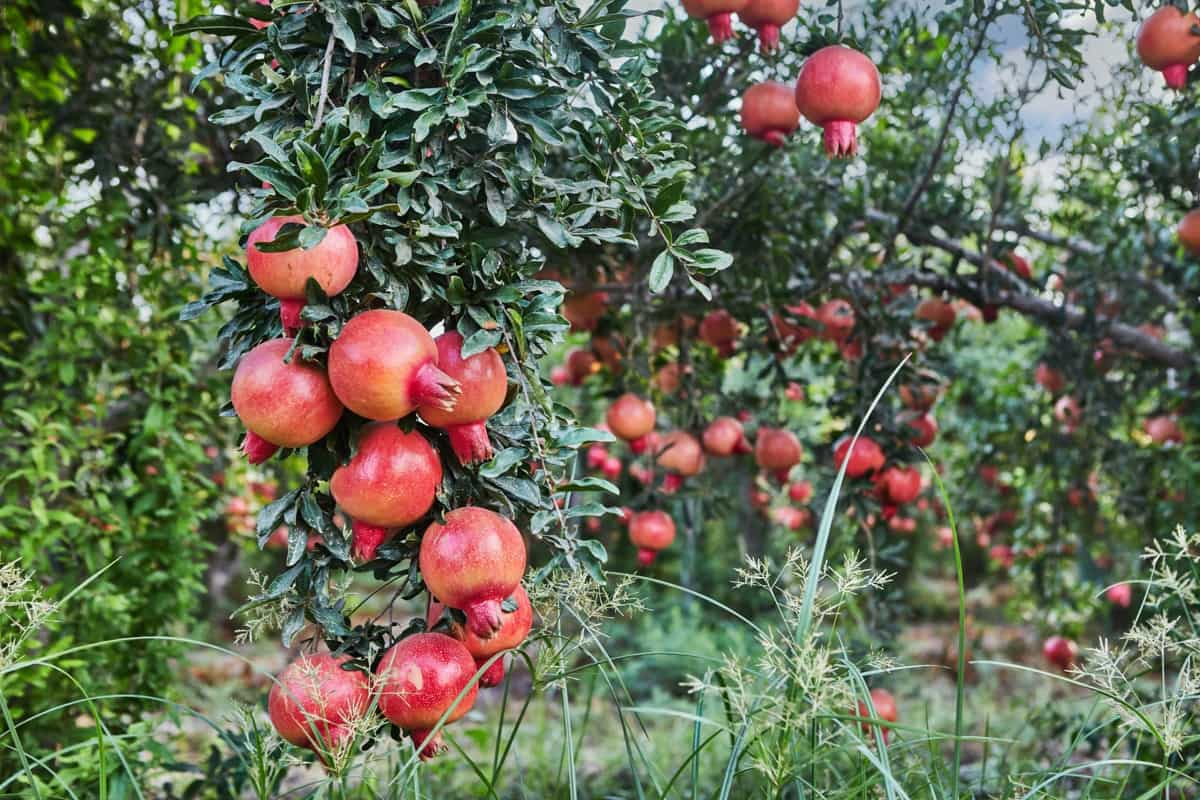
Introduction to Bahar Treatment in Pomegranate for High Quality and Yields
Bahar treatment is a horticultural practice in pomegranate cultivation, primarily aimed at optimizing yield and fruit quality. In regions with tropical climates, pomegranate trees can bloom year-round, but this continuous flowering results in irregular fruiting with smaller-sized fruits.
This consistency could be more commercially desirable and lead to higher yields. To address this, Bahar treatment is employed. Bahar treatment involves carefully timed pruning and the induction of flowering during specific desired seasons. By strategically controlling vegetative growth and flowering, growers can synchronize the fruiting patterns of pomegranate trees.
This synchronization ensures that the fruits mature uniformly in size and quality, making them more marketable and economically viable. Identifying the right Bahar for treatment becomes critical in subtropical regions like central and western India, with multiple flowering seasons. The choice of Bahar should consider various factors to maximize the chances of a productive crop.
Understanding the Importance of Bahar Treatment in Pomegranate Cultivation
Regulating Flowering Patterns: Pomegranate trees can flower year-round with adequate moisture, but continuous flowering leads to irregular fruiting and smaller fruit sizes. Bahar treatment synchronizes flowering, ensuring a more uniform fruiting pattern for commercial viability and higher yields.
Enhancing Airflow and Reducing Humidity: Pruning and thinning during Bahar treatment open the canopy, increasing airflow within the orchard. Reduced humidity levels minimize the risk of fungal diseases and pests, promoting overall tree health.
Improving Fruit Quality: Bahar treatment allows for the selective removal of branches and leaves, ensuring that the remaining branches receive more sunlight and nutrients. This results in improved fruit quality, including better color, size, and flavor, making the pomegranates more appealing to consumers.
Optimizing Pest and Disease Management: By reducing excess foliage and enhancing airflow, Bahar treatment creates an environment less conducive to pest and disease development. This reduces reliance on chemical treatments and fosters a more sustainable pest and disease management approach.
Increasing Yield and Profitability: Through improved fruit quality, synchronized flowering, and reduced pest and disease pressures, Bahar treatment significantly increases yield. Higher yields translate into increased profitability for pomegranate growers.
In case you missed it: Maximizing Farmer’s Income: The Art of Pomegranate Intercropping
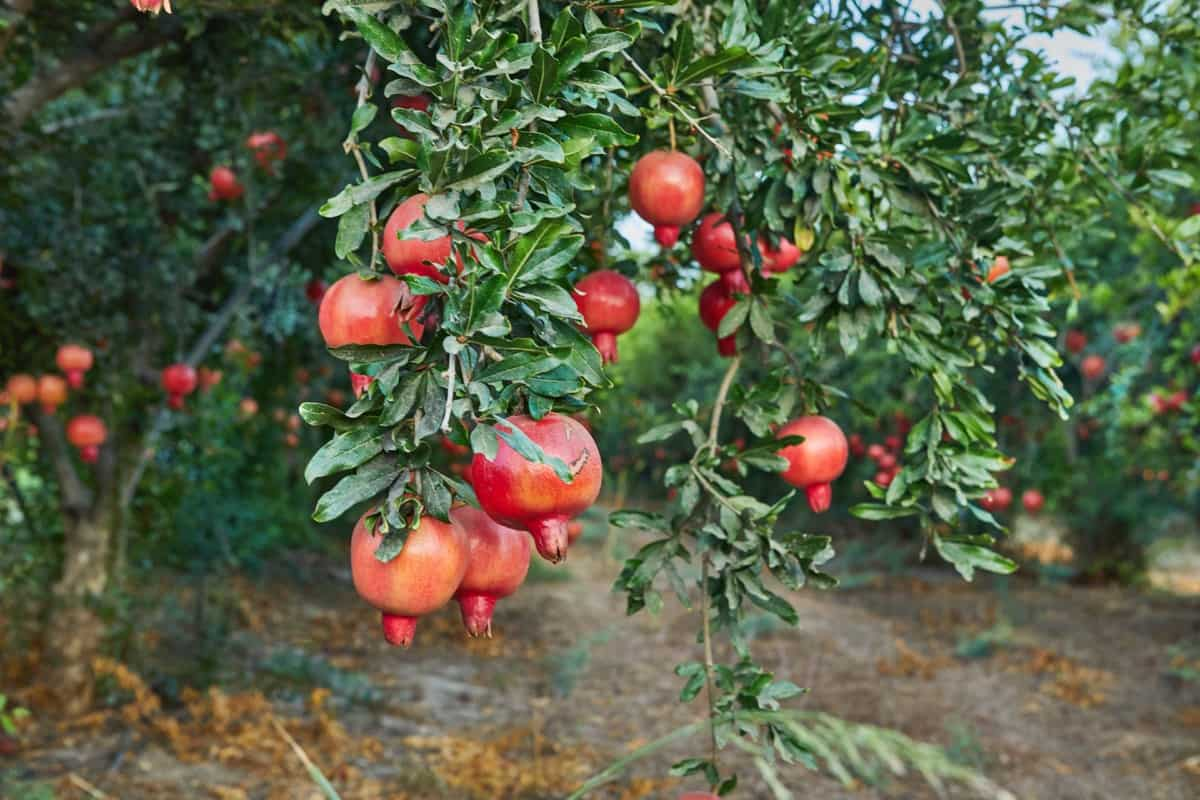
The Science Behind Bahar Treatment and its Effects on Pomegranate Trees
- Seasonal Suitability: Crop regulation ensures that pomegranate trees produce fruit at desired times, aligning with market demand and favorable conditions.
- Quality and Uniformity: It promotes the growth of uniform, high-quality fruits essential for market competitiveness and consumer satisfaction.
- Maximizing Production and Profit: By synchronizing flowering and fruiting, crop regulation increases production and profits for growers.
- Cost Efficiency: Continuous, uninterrupted blooming throughout the year results in light crops and elevated monitoring and marketing costs. Crop regulation mitigates these expenses.
- Commercial Viability: Pomegranate trees exhibit various flowering seasons, including Ambebahar (spring), Mrigbahar (June-July), and Hastabahar (August-September). Focusing on a single harvest each year is crucial to ensure commercial viability.
- Location and Environmental Factors: The choice of Bahar (flowering season) depends on factors like water availability, fruit quality, market prices, and disease and pest prevalence, in addition to geographical location.
- Water Conservation: Water scarcity in arid and semi-arid regions is challenging for pomegranate growers. Some Bahar selections, like Hastabahar, are preferred due to their lower water requirements, helping conserve this precious resource.
Step-by-Step Guide to Implementing Bahar Treatment in Pomegranate Orchards
- Selection of Suitable Trees: Choose mature and healthy pomegranate trees for Bahar treatment. Healthy trees respond better to the treatment.
- Timing is Essential: Initiate Bahar treatment during the winter dormant, typically between late January and early February. This period is ideal for manipulating tree growth.
- Pruning and Defoliation: Prune excess branches to create an open canopy and remove a portion of leaves to stimulate growth synchronization. Pruning helps redirect the tree’s energy toward flowering.
- Application of Growth Regulators: Use growth regulators like Ethephon to induce flowering. Apply them according to recommended rates and guidelines.
- Monitor and Care: Regularly assess tree growth and health during treatment. Adequate irrigation and nutrition are crucial to support new growth.
- Weather Consideration: Pay attention to local weather conditions and forecasts. Avoid treatment during periods of extreme cold or frost.
- Post-Treatment Care: Continue monitoring the orchard after treatment. Provide necessary care to promote healthy fruit development.
- Harvest Timing: Be mindful of the Bahar’s effect on flowering timing. Harvest the pomegranates at the appropriate stage for optimal quality.
In case you missed it: Fruit Borer in Pomegranate: Symptoms, Causes, Control, and Treatment
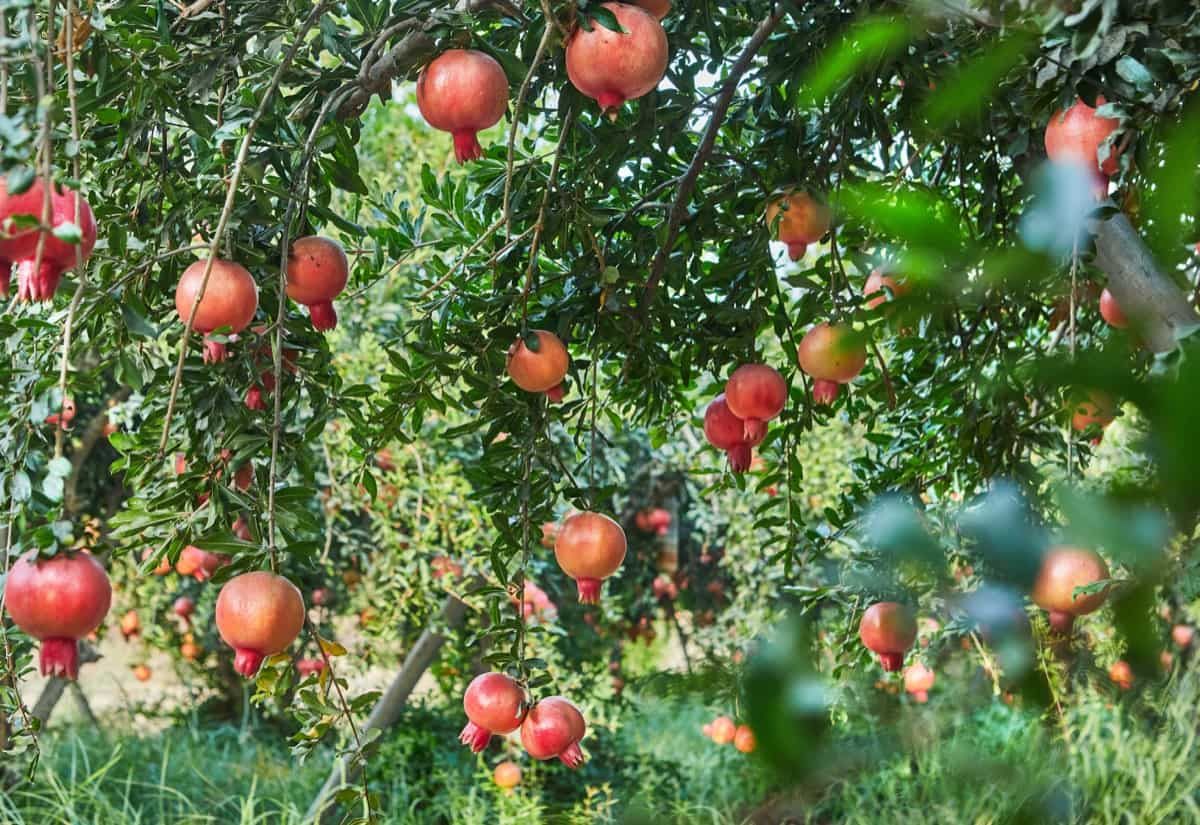
Factors Affecting the Success of Bahar Treatment in Pomegranate Trees
- Climate: Weather conditions, including temperature and rainfall patterns, influence the effectiveness of Bahar treatment. Optimal treatments align with local climate conditions.
- Variety: Different pomegranate varieties exhibit varying responses to Bahar treatment. Understanding the variety’s flowering habits is essential for success.
- Water Availability: Adequate water during the treatment phase is crucial. Drought or over-irrigation can disrupt stress induction and flowering.
- Disease and Pest Management: Managing pests and diseases before and during treatment is vital to prevent infestations that can hinder success.
- Pruning Practices: Precision in canopy pruning and defoliation techniques impacts flowering synchronization.
- Nutrient Application: Proper nutrient dosage and timing enhance the treatment’s effectiveness, promoting better yields and fruit quality.
Optimal Timing for Bahar Treatment in Pomegranate Cultivation
Mrig Bahar (June-July)
- Suitable for areas with reliable rainfall from June to September.
- Harvesting period: December to February.
- Advantages: Flowering and fruiting coincide with the rainy season or immediately after, ensuring sufficient moisture for fruit development.
Hasta Bahar (September-October)
- Beneficial for regions with erratic monsoon patterns starting in August.
- Harvesting period: March to April.
- Market appeal: Pomegranates from this season have a visually appealing rind, dark-colored arils, and limited availability, resulting in higher market value.
Ambia Bahar (January-February)
- Suitable for areas with assured irrigation in April-May or where the monsoon starts early and ends by September.
- Harvesting Period: June to September.
- Export-quality: Dry weather during fruit development contributes to attractive color and quality, making this season ideal for export-quality fruits.
In case you missed it: How this Farmer Made 42 Lakhs from 5 Acres of Organic Pomegranate Farming: Fruit Cultivation Sucess Story in India
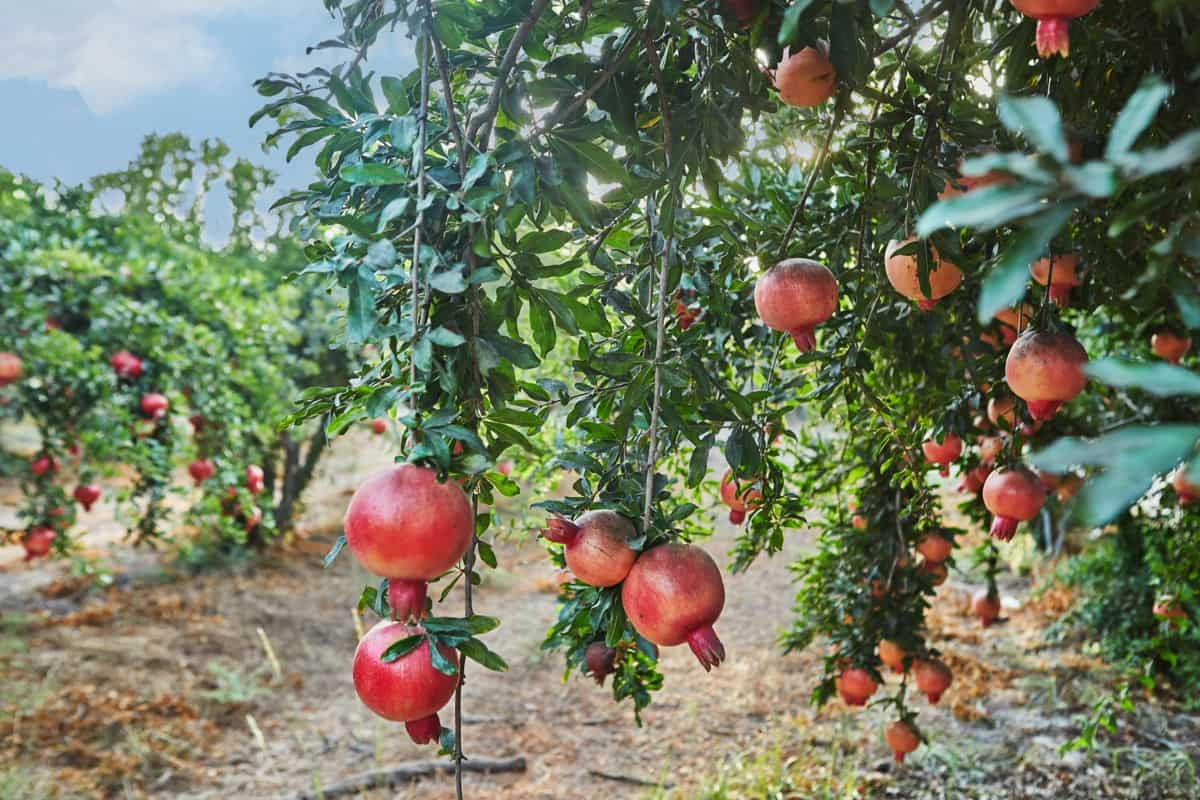
Techniques and Methods for Applying Bahar Treatment in Pomegranate Orchards
Moisture Stress Preparation
- In light sandy soil, stop irrigation at least 30-35 days before Bahar treatment.
- In sandy loam soil, halt irrigation for 40-45 days or up to 2 months before Bahar treatment.
Canopy Pruning
- Around 40-45 days after stopping irrigation, prune the pomegranate trees to achieve a proper canopy shape. This prepares the trees for the treatment.
Ethrel Spray and Defoliation
- Within two days after pruning, spray a mixture of Ethrel (2.5 ml/liter) and DAP (5 gm/liter) on the pruned trees for defoliation.
- After achieving 80-85% leaf fall due to defoliation, perform light pruning (15-25 cm) to stimulate further growth.
Nutrient Application
- Apply the required nutrients to the soil within 2-3 days after pruning. The suggested nutrient quantities are for 2-5-year-old crops, and adjustments are needed based on crop age and plant size.
Nutrient Dosage per plant
- Organic (FYM): 20 kg
- Nitrogen (Ammonium Sulphate): 2 kg
- Phosphorus (Single Super Phosphate – SSP): 1.6 kg
- Potassium (Muriate of Potash – MOP): 1.3 kg
- Zinc (Chelated liquid zinc): 3-5 ml/liter of water
- Magnesium (Magnesium Sulphate – 0.2%): 2 gm/liter of water
- Boron (Boron 20%): 1 gm/liter of water
Water Management
- After applying nutrients, cover them with soil (earthing up) and provide light irrigation. The first irrigation may be slightly higher (8-12 liters/plant), depending on plant age and size.
- Reduce the irrigation quantity by half for the next two days to avoid excess water.
- After the third irrigation, withhold irrigation for 5-6 days to promote stress.
Benefits of Bahar Treatment on Pomegranate Fruit Quality and Yields
Bahar treatment improves pomegranate fruit quality and yields by synchronizing flowering, resulting in consistent fruit development. This results in improved color and flavor due to reduced resource competition. Synchronized flowering yields higher yields, making the fruits more marketable and profitable. Additionally, controlled growth minimizes pest and disease pressure, reducing humidity and pest-friendly conditions.
In case you missed it: High Yield Hybrid Pomegranate Varieties in India: State Wise
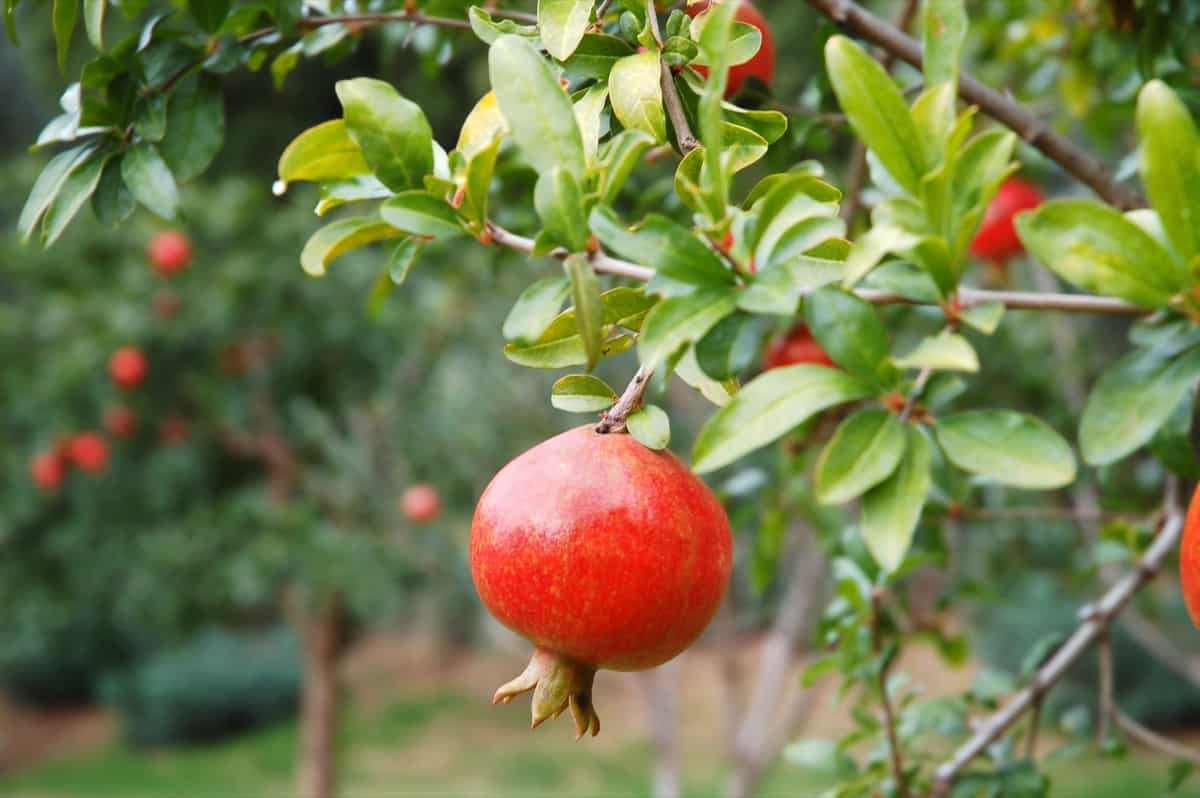
Common Challenges and Solutions in Implementing Bahar Treatment in Pomegranate Orchards
The implementation of Bahar treatment in pomegranate orchards faces several challenges. These include unpredictable weather patterns, pest and disease infestations, water scarcity, inadequate pruning practices, and variety-specific considerations. Monitoring weather forecasts, adjusting treatment timing, and installing protective measures to address these issues is crucial.
Integrated pest and disease management practices, including regular monitoring and timely interventions, can help manage pests and diseases. Efficient water use and irrigation alternatives like drip systems can help in arid regions. Proper pruning techniques and training of workers can also help ensure growth synchronization. Tailoring Bahar treatment approaches to specific pomegranate varieties can also help.
Monitoring and Evaluating the Effects of Bahar Treatment on Pomegranate Trees
This process involves regularly observing tree health, flowering patterns, and fruit development. Fruit size, color, and yield measurements are recorded and compared to pre-treatment conditions. Additionally, pest and disease incidence is monitored. Evaluations help determine the success of Bahar treatment, ensuring that the desired objectives, such as synchronized flowering, enhanced fruit quality, and increased yields, are met. Based on the findings, treatment strategies can be adjusted, optimizing future Bahar treatments for improved pomegranate production.
Best Practices for Maximizing the Results of Bahar Treatment in Pomegranate Cultivation
Crop Regulation Objective: The primary goal of crop regulation is to manipulate the natural flowering of pomegranate plants to maximize fruit yield, quality, and profitability. It optimizes resource utilization and ensures consistent, high-quality fruit production.
Environmental and Genetic Factors: Flowering in pomegranates is influenced by environmental factors and genetics. Pomegranate trees exhibit intermittent blooming in arid and semi-arid regions from February to October.
Commercial Viability: Commercial pomegranate varieties are susceptible to diseases and pests, making flower regulation crucial. Common issues include Bacterial Leaf Blight, Scorching, Nematode, Termite, and Mite infestations.
Factors Influencing Flowering: Multiple factors impact flowering, including irrigation withholding, defoliants, plant growth hormones, nutrient levels, and canopy management (pruning and training).
Irrigation and Defoliation: Irrigation is halted one to two months before the desired Bahar, followed by minor pruning and the use of ethrels defoliant to remove leaves. Topsoil around the tree is dug up, manure and fertilizers are added, and light watering is performed.
Stress-Induced Flowering: Water scarcity is a stress-inducing mechanism to promote flowering. It results in an increased number of flowers and the accumulation of food resources for future growth.
Chemical Induction: Foliar spraying of ethrel is widely used to induce flowering in pomegranates. Ethrel stimulates enzymes for cell softening, leading to more flowers, a better sex ratio, and increased yield.
Cultural Practices and Canopy Management: Canopy management techniques such as training, trimming, and controlling the carbon-nitrogen ratio through fertilization are employed to achieve higher flowering percentages and quality fruit production.
Disease and Pest Management: Crop regulation aids in controlling insect pests and diseases. Fallen leaves, influenced by the dose of defoliant, are collected and burned to eliminate potential sources of infestation, reducing the need for insecticide use.
Seasonal Regulation: Different Bahar seasons (e.g., Mrigbahar, Hasta Bahar, and Ambia Bahar) are chosen based on water availability, climate, market demand, and pest and disease prevalence.
In case you missed it: Fertilizer Management in Pomegranate Trees: Organic, Homemade, Liquid, NPK, Schedule, and Application
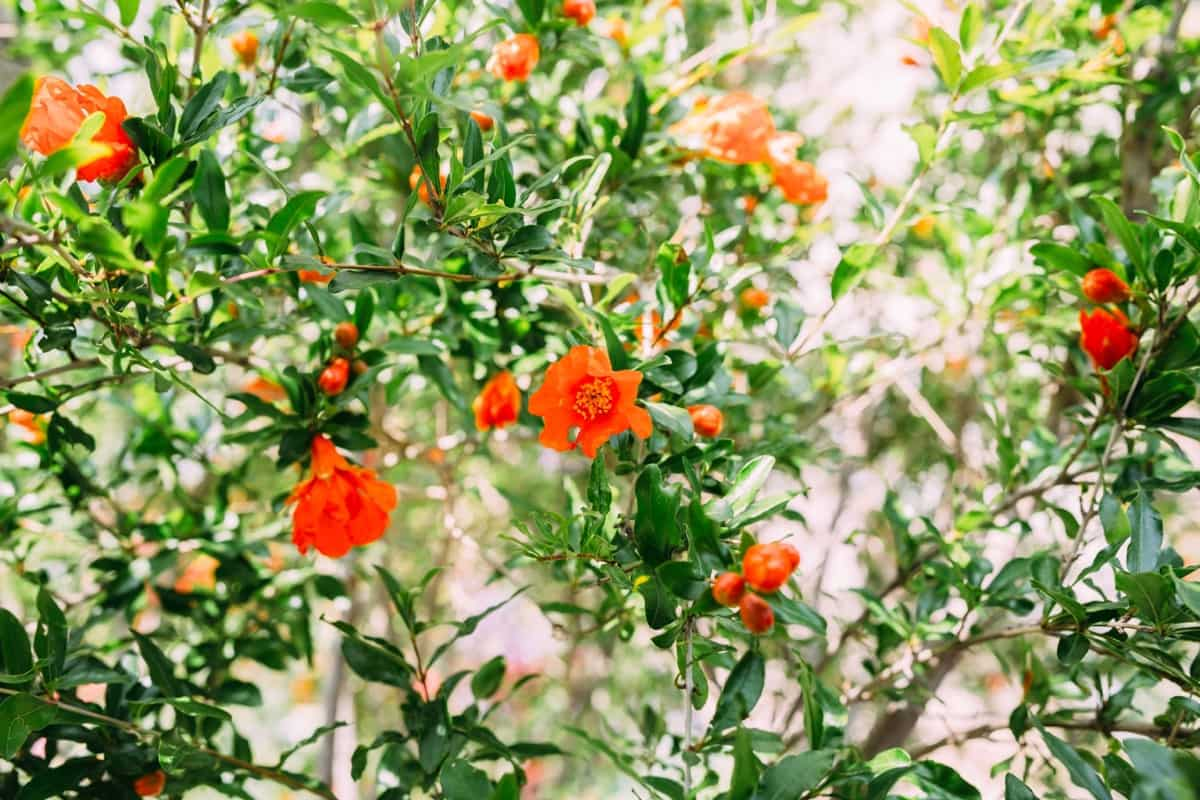
Economic Considerations and Return on Investment for Bahar Treatment in Pomegranate Orchards
Costs include expenses for pruning, defoliation agents like Ethrel, nutrient application, labor, and potential irrigation adjustments. On the other hand, the return on investment is measured by increased yield, improved fruit quality, and higher market prices for uniform, high-quality fruits. Research indicates that Bahar treatment can increase yield by 20-30%, with enhanced fruit quality. The economic benefit typically outweighs the treatment costs, leading to higher profitability for pomegranate growers, making Bahar treatment a financially viable practice in cultivation.
Comparison of Different Bahar Treatment Approaches for Pomegranate Trees
Traditional pruning methods involve manual labor and defoliation, while chemical induction like ethrel sprays offers efficient defoliation but adds costs. Stress-induced flowering promotes flowering, reducing costs but relying on climate conditions. Nutrient-rich soil amendments improve flowering and fruiting, adding costs but enhancing long-term yield. Integrated pest and disease management during Bahar treatment reduces infestation risks and incurs pesticide costs.
Potential Risks and Precautions Associated with Bahar Treatment in Pomegranate Cultivation
- Weather Variability: Unpredictable weather patterns can disrupt treatment timing. Precaution: Monitor forecasts and adjust treatment schedules accordingly.
- Pest and Disease Incidence: Stress-induced growth may make trees more vulnerable to pests and diseases. Precaution: Implement pest and disease management practices during Bahar treatment.
- Over-Irrigation: Excessive watering can negate stress induction. Precaution: Optimize irrigation practices to avoid over-watering.
- Varietal Differences: Different pomegranate varieties respond uniquely to Bahar treatment. Precaution: Tailor treatment to the specific needs of the cultivated variety.
- Nutrient Imbalance: Inaccurate nutrient application can lead to imbalances. Precaution: Follow recommended nutrient dosages and application methods.
- Labor Costs: Manual pruning and treatment may require substantial labor. Precaution: Plan labor requirements and costs in advance.
Conclusion
Bahar treatment is valuable in pomegranate cultivation, enhancing fruit quality and yields. Properly timed and executed, it synchronizes flowering, optimizes resources, and minimizes risks. This step-by-step guide provides growers with a structured approach to maximize the benefits of Bahar treatment in their orchards.
- Types of Pesticides Used in Agriculture: A Beginner’s Guide
- Economical Aquaculture: A Guide to Low-Budget Fish Farming
- 15 Common Planting Errors That Can Doom Your Fruit Trees
- How to Make Houseplants Bushy: Effective Tips and Ideas
- Innovative Strategies for Boosting Coconut Pollination and Yield
- Pollination Strategies for Maximum Pumpkin Yield
- The Complete Guide to Chicken Fattening: Strategies for Maximum Growth
- Natural Solutions for Tulip Problems: 100% Effective Remedies for Leaf and Bulb-Related Issues
- Revolutionizing Citrus Preservation: Towards a Healthier, Greener Future
- Natural Solutions for Peony Leaf and Flower Problems: 100% Effective Remedies
- Maximizing Profits with Avocado Contract Farming in India: A Comprehensive Guide
- Natural Solutions for Hydrangea Problems: 100% Effective Remedies for Leaf and Flowers
- The Ultimate Guide to Choosing the Perfect Foliage Friend: Bringing Life Indoors
- From Sunlight to Sustainability: 15 Ways to Use Solar Technology in Agriculture
- The Ultimate Guide to Dong Tao Chicken: Exploring from History to Raising
- The Eco-Friendly Makeover: How to Convert Your Unused Swimming Pool into a Fish Pond
- Mastering the Art of Delaware Chicken Farming: Essentials for Healthy Backyard Flocks
- 20 Best Homemade Fertilizers for Money Plant: DIY Recipes and Application Methods
- How to Craft a Comprehensive Free-Range Chicken Farming Business Plan
- Brighten Your Flock: Raising Easter Egger Chickens for Beauty and Bounty
- How to Optimize Your Poultry Egg Farm Business Plan with These Strategies
- Subsidy for Spirulina Cultivation: How Indian Government Schemes Encouraging Spirulina Farmers
- Ultimate Guide to Raising Dominique Chickens: Breeding, Feeding, Egg-Production, and Care
- Mastering the Art of Raising Jersey Giant Chickens: Care, Feeding, and More
- Ultimate Guide to Raising Legbar Chickens: Breeding, Farming Practices, Diet, Egg-Production
- How to Raise Welsummer Chickens: A Comprehensive Guide for Beginners
- How to Protect Indoor Plants in Winter: A Comprehensive Guide
- Ultimate Guide to Grow Bag Gardening: Tips, Tricks, and Planting Ideas for Urban Gardeners
- Guide to Lotus Cultivation: How to Propagate, Plant, Grow, Care, Cost, and Profit
- Agriculture Drone Subsidy Scheme: Government Kisan Subsidy, License, and How to Apply Online
- Ultimate Guide to Raising Araucana Chickens: Breed Profile, Farming Economics, Diet, and Care
- Bringing Hydroponics to Classroom: Importance, Benefits of Learning for School Students
- Ultimate Guide to Raising Polish Chickens: Breed Profile, Farming Economics, Diet, and Care
- Ultimate Guide to Raising Australorp Chickens: Profile, Farming Economics, Egg Production, Diet, and Care
- Silkie Chicken Farming: Raising Practices, Varieties, Egg Production, Diet, and Care
- Sussex Chicken Farming: Raising Practices, Varieties, Egg Production, Diet and Care